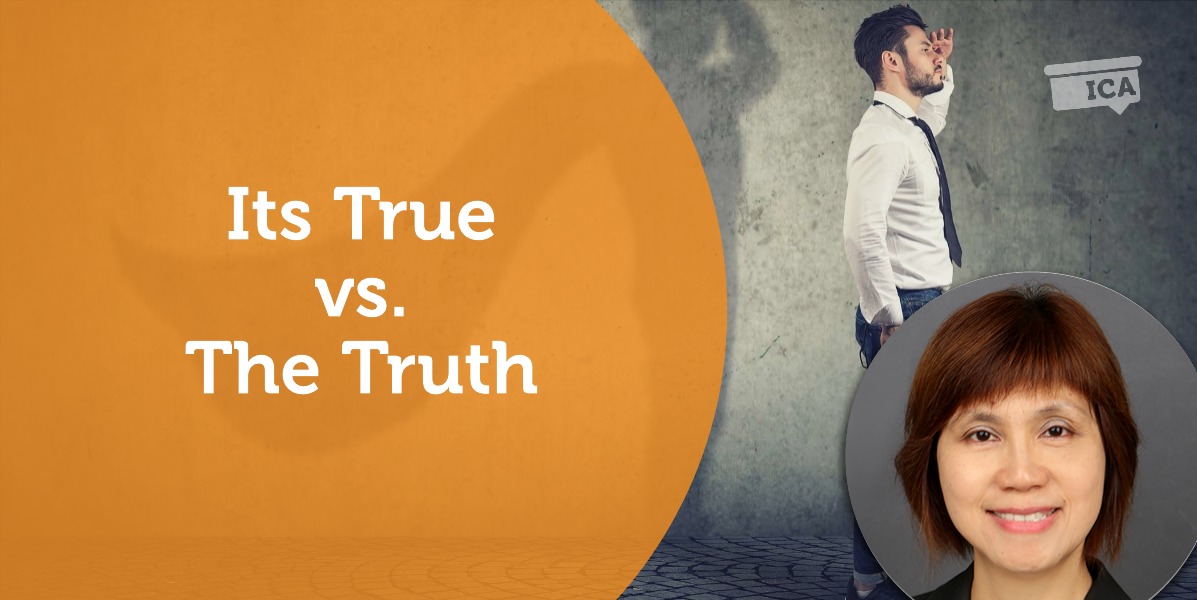 A Coaching Power Tool Created by Yin Leng Choy
A Coaching Power Tool Created by Yin Leng Choy
(Career and Life Coach, SINGAPORE)
 Many times, we believe what we see with our eyes. However, how many times do we challenge or question what we SEE? Have we or Do we cross our minds that what we see may only be the partial truth? Is there something like the whole truth?
Many times, we believe what we see with our eyes. However, how many times do we challenge or question what we SEE? Have we or Do we cross our minds that what we see may only be the partial truth? Is there something like the whole truth?
When we believe in the partial truth that we see, the ideas or the beliefs that we formed from the partial truth, can be said to be judgemental. This is because it does not represent the whole truth.
Let me illustrate with an example to clarify my points.
Scenario
I was reading in a park while my daughter, 5 years old then, was playing in the playground. She was going to reach for the swing and was about to mount on it. Although with a book in my hands, my watchful eyes had not left her for a moment. Just as I was happily contemplating as a proud mother to see how she was maneuvering to mount the swing, a taller boy about her age came running, and with swift action, he pushed her away and mounted the swing!
Witnessing such an outrageous action being carried out on my daughter, what do you think as a mother would react? I was speechless for a moment because I was taken by surprise. When I gathered my composure, I ran to my daughter and was on the verge to open my mouth to berate the boy!
Then came a lady about my age, running to the scene. Immediately, I presumed this woman to be the boy’s mother and again was about to voice my displeasure. I was about to say something sarcastic or hurtful to her when she apologetically kept saying sorry to me. Still, I wanted to tell her to better discipline her son. If he can bully others at this age, what would become of him in the future? I believed that what he had done is unacceptable!
The next sentence from this woman silenced me. Once again, I was speechless! For a moment, I thought I was like a goldfish with popping eyes and opened mouth that I did not know how and what to react. Floating into my ears was this sentence, “ I am so sorry. You see, my son is autistic. He doesn’t know how to interact with people. I am sorry.” Hurriedly, she dragged her rebelling son away from the playground. I was still speechless. Suddenly, a sense of guilt and sympathy aroused in me. I regretted my initial thoughts on judging the poor boy and the mother. I wanted to tell her that it’s ok. I wanted to tell her both my daughter and myself would embrace him. Watching her frail back struggling to tame the boy gradually faded from my sight, my heartfelt so remorseful that I thought I would stop breathing.
This short encounter taught me a great lesson. Although seeing is believing, we may be seeing only the partial truth. If we formed judgment based on partial truth, high chances are that our conclusion may not be complete. It was after hearing the explanation of the mother of the boy that gave a better insight into the whole scenario. This created a better understanding of the situation as to why and how the boy reacted in such a way. With this better insight and understanding, the judgment of the boy being a bully and a mother who condoned the wrongdoings of her child disappeared. The picture of the jigsaw puzzle became so much clearer.
Application to coaching
When the client comes to us, what is going through the coaches’ minds? Coaches must meet their clients with a mind like a white canvas. There should be no preoccupied thoughts or presumptions in the minds of coaches when faced with clients. Clients should not be judged based on their attire, their behaviors, and actions. Judging deters coaches to make objective questioning and better understand the client’s situation.
The coach’s mind must be like a white canvas and let the client paints and put whatever colors they desired on to the canvas. The coach, however, can challenge them or ask them powerful questions.
Many times when clients tell us so call ‘problem’ is just the tip of an iceberg or (its true or partial truth). Like the iceberg metaphor, what is seen is our behavior which represents by the ice above water. The real issue or our behavior is influenced by many drivers and underlying beliefs which can be represented by the ice below the water (the truth or the whole truth).
Helping our clients to dive deep into their inner core of the matter and explore how to manage their own emotions or reframing their perspectives could help them work on their desired goals.
A client said that the company in which he was working as a contract project consultant was told that the company would not extend his contract when it ends. He was of course very disappointed. When this fact sank in, there was a twist of the event due to COVID-19 and the company decided to extend his contract for a year instead of the normal 6 months. This was supposed to be happy news yet this client was not happy and was contemplating not to extend with the company. He was in a dilemma as to whether he would accept the offer or reject it. He wanted to explore the clarity as to why he was not happy at the delayed offer.
So the tip of the iceberg of his problem (which can be seen as its true or partial truth), is that he was not happy and excited about the extended contract offered to him. If that is so, why did he feel so disappointed when he did not get it initially? If he is not interested in the job offer, why did he mention several times in the coaching conversation that it bothered him and he needed some clarity on his reaction?
When we go deeper and deeper and reach the submerged iceberg, (or the underlying beliefs or the ‘Truth’ or the whole truth), he finally said it was his self-doubt and ego.
Self-doubt because of his first rejection. He felt he was maybe not up to the mark of the company and he was disappointed. The thought of him being the company’s ‘second choice’ dampened his ego. When he was offered the extension of his contract, his ‘ego’ tells him that he was presumed to be ‘not up to expectation’, and yet later when the need arose, he was pulled in again. This has ‘offended’ his ‘ego’ and he was not very keen to accept the offer.
On the other hand, he wanted the job and this contradiction of emotions bothered him which resulted in what we see as the tip of the iceberg. So it’s True that he was reluctant to take up the job offer. However, the Truth is his pride prevented him from doing so.
Conclusion
What we see with our naked eyes are perceived as ‘it’s true’. When we deep dive into the submerged iceberg, we will see ‘The Truth’. Many times, it is ‘the truth’ that triggers what we see as ‘it’s true’. Hence, to remain as a mind blank as a white canvas, we need to explore, deep dive, and discover what is ‘the truth’ behind just being ‘it’s true’.